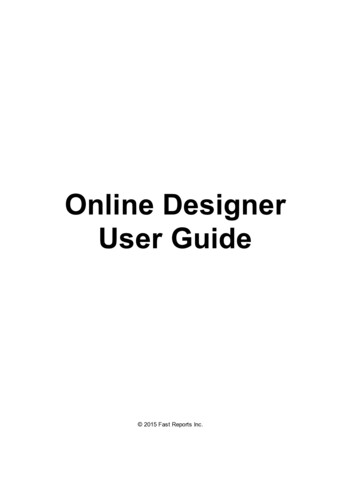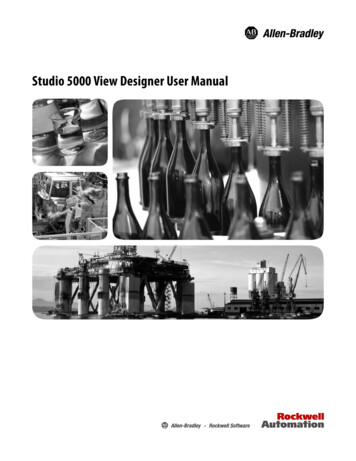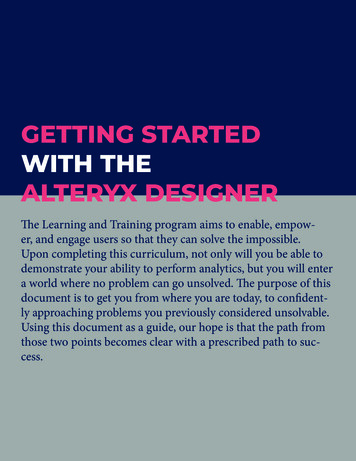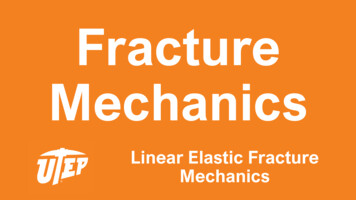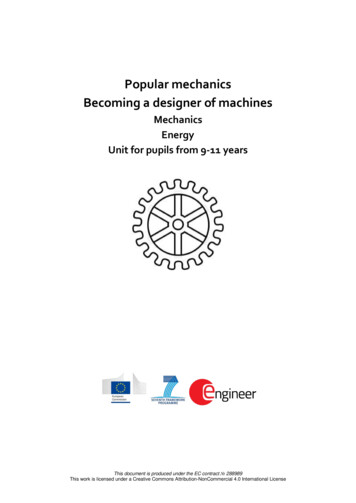
Transcription
Popular mechanicsBecoming a designer of machinesMechanicsEnergyUnit for pupils from 9-11 yearsThis document is produced under the EC contract 288989This work is licensed under a Creative Commons Attribution-NonCommercial 4.0 International License
IntroductionThis is one of ten ENGINEER primary school units developed to support science learning within thecontext of a wide range of engineering design challenges. Based on the successful Boston Museumof Science Engineering is Elementary model of inquiry-based learning, each unit features a differentscience area and engineering field and requires only inexpensive materials in order to support pupilled science exploration and problem-solving design. The units have been developed to appeal to awide range of pupils and to challenge stereotypes of engineering and engineers and so enhanceboth boys’ and girls’ participation in science, technology and engineering.Our pedagogic approachCentral to each unit is the engineering design cycle: ask, imagine, plan, create, improve.Emphasizing the cycle helps teachers to foster pupils’ questioning and creativity, and gives space forpupils to develop their problem-solving skills including testing alternative options, interpretingresults and evaluating their solutions. Tasks and challenges have been designed to be as openended as possible, and to avoid ‘right answers’; in particular, the unit developers have aimed toavoid competition which may alienate some pupils, while retaining the motivation of wanting tosolve a problem. An important goal of all of the units is to maximise opportunities for group workand to support pupils in learning to work together and communicate their ideas effectively.Students need to discuss their ideas as they explore a new problem, work out what they need toknow and share their findings, design solutions, and then improvements.How the units are organisedEach unit begins with Lesson 0, a general preparatory lesson which is common to all ten units.Teachers choosing to use more than one unit will want to start with this lesson the first time theyuse the units and begin at Lesson 1 in subsequent units. Lesson 1 introduces a story context orproblem which drives what happens next: Lesson 2 focuses on what exploring the science that thepupils need to solve the problem, while in Lesson 3 they design and build their design solution.Finally, Lesson 4 is an opportunity to evaluate, present, and discuss what they have done.Each unit is, however, unique, and some units are more demanding in terms of scienceunderstanding and the length of time required for the unit varies. Likely timings and age targets areindicated in each unit overview. Units have been designed to be flexible, however – teachers canchoose which activities they want to include, and there are options for differentiating activities tocater for a range of abilities.Teacher supportEach unit guide has been written to provide appropriate science, technical and pedagogic supportfor teachers with a wide range of experience and expertise. Each lesson includes suggestions andtips for supporting inquiry-based learning, classroom organisation and preparation. Science andmaking activities are illustrated with photographs. Science pedagogy notes in the Appendix explainand discuss the science involved in the unit and how to support understanding of the centralconcepts for pupils in the age range. Worksheets which can be copied and answer keys are alsoprovided.This document is produced under the EC contract 288989This work is licensed under a Creative Commons Attribution-NonCommercial 4.0 International License2
IndexIntroduction . 2Overview of the unit . 5Resources . 6Lesson 0 – Engineering an envelope . 100.1 Introduction - 10 minutes - small group and whole class discussion . 110.2 Activity 1 What is an envelope? - 5 minutes, small groups . 110.3 Activity 2 Matching envelopes to objects - 15 minutes - small groups and whole class discussion . 120.4 Extension work - optional - 10-30 minutes - small groups. 120.5 Conclusion – 10 minutes - whole class discussion . 130.6 Learning outcomes - for optional assessment . 14Lesson 1 – What is the engineering problem? . 151.1 Introductory activity – set the context – class discussion - 10 minutes. 161.2 Define an object using a mechanism – working in teams – 25 minutes . 161.3 Group presentations and establishing the key learning points - 25 minutes . 161.4 Conclusion – plenary - 10 minutes . 17Lesson 2 – What do we need to know? . 182.1 Introductory activity – review previous lesson – whole class discussion – 15 minutes. 192.2 What’s happening inside a mechanical object? – working in groups – 20 minutes . 192.3 Discovering cams! – Working in Groups - 80 minutes . 192.4 Extension Activity: Discovering gears! – Working in teams - 80 minutes . 202.5 Conclusion – Plenary - 5 minutes . 21Lesson 3 – Let’s build! . 223.1 Introductory activity – review previous lesson – class discussion - 10 minutes . 233.2 Mechanical toys – working in groups - 60 minutes . 233.3 Extension activity - the counter – working in groups - 80 minutes . 233.4 Conclusion – plenary - 30 minutes . 24Lesson 4 – How did we do? . 254.1 Introductory activity – class discussion - 15 minutes . 26The teacher along with the pupils sums up the achievements in Lesson 3. . 264.2 Improvements – working in teams – 60 minutes . 264.3 Conclusion – plenary - 25 minutes . 26Engineering design cycle . 27Story to set the context . 28Worksheets and answer sheets . 30Worksheet 1 Lesson 0 – Engineering?. 31Worksheet 1 Lesson 0 - Engineering? – Teacher notes. 32Worksheet 1 Lesson 1 - Find a mechanical object . 33Answer sheet Worksheet 1 Lesson 1 - Find a mechanical object . 34Worksheet 1 Lesson 2 - Define a mechanical object. 36Worksheet 1 Lesson 2 - Define a mechanical object. 37Worksheet 1 Lesson 2 - Define a mechanical object. 38Worksheet 1 Lesson 2 - Define a mechanical object. 39Answer sheet Worksheet 1 Lesson 2 - Define a mechanical object . 40Answer sheet Worksheet 1 Lesson 2 - Define a mechanical object . 41Answer sheet Worksheet 1 Lesson 2 - Define a mechanical object . 42Answer sheet Worksheet 1 Lesson 2 - Define a mechanical object . 43Worksheet 2 Lesson 2 - Let’s play with cams! (1/3) . 44Worksheet 3 Lesson 2 - Let’s play with cams! (2/3) . 46This document is produced under the EC contract 288989This work is licensed under a Creative Commons Attribution-NonCommercial 4.0 International License3
Answer sheet Worksheet 3 Lesson 2 - Let’s play with cams! (2/3) . 47Worksheet 4 Lesson 2 - Let’s play with cams! (3/3) . 49Answer sheet Worksheet 4 Lesson 2 - Let’s play with cams! (3/3) . 49Worksheet 5 Lesson 2 - Let’s play with gears! . 51Answer sheet Worksheet 5 Lesson 2 - Let’s play with gears! . 52Suggestions for constructing mechanical objects . 54How to build a mechanical toy . 54How to build the counter? . 58Template for the ‘unit’ wheel . 60Science notes for teachers about mechanics . 61Some pupils’ ideas about mechanics science concepts . 63Partners . 65This document is produced under the EC contract 288989This work is licensed under a Creative Commons Attribution-NonCommercial 4.0 International License4
Overview of the unitDuration: 6 hours and 40 minutes (400 minutes)Target group: 9, 10 and 11 year old pupilsDescription: by participating in the challenge to create mechanical machines (toys, or a counter) the pupilsbecome engineers and learn about Mechanics with a focus on transmission and transformation of motion.During this unit, the pupils manipulate real objects to describe the simple elements of Mechanics (cams, levels,gears) and use them as tools to understand how an object works. , The pupils use simple materials to test alltheir hypotheses and ideas and then improve them. Pupils work in groups and present and discuss theirproposals. This process is seen as a way to interest pupils in science and engineering, no matter whatdifficulties they may face. The activities are linked with a story and pupils need to solve a challenge. The finalevaluation lesson enables pupils to discuss whether they have created an object that works.Science curriculum: this unit relates to the science curriculum for machines created by the human being.Engineering field: this unit introduces the field of mechanical engineering.Objectives; in this unit the pupils will learn: how to apply some key elements of basic engineering to the creation of a mechanical toy; to understand and appreciate the science of force and movement involved in the project; to apply the Engineering Design Cycle to meeting engineering challenges.The lessons in this unit:A Preparatory lesson aimed at raising awareness of how engineering contributes to our daily lives in waysthat are not always obvious.Lesson 1 introduces the engineering problem, its context and the engineering process: pupils must imagine acounter to count visitors and/or create mechanical toys to tell stories. Pupils are asked to define and analysehow a mechanical motion could be transmitted and transformed.In Lesson 2 the ‘ask’ element of the engineering process leads to an investigation of mechanical engineering.The teacher can choose to construct a counter and explore gears or alternatively mechanical toys andexploring cams. This lesson is an opportunity to gather necessary knowledge to create pupils’ own mechanicalobject.Lesson 3 involves the pupils in applying the engineering design process to meet the challenge, to createmechanical objects (toys or counter). Pupils can start with a solution suggested in the teacher guide or inventone by testing different materials.In Lesson 4 it’s time to evaluate the process of creating the mechanical toys or the counter. This is also themoment for pupils to show if they were able to meet all the criteria and to talk about how they madeimprovements.This document is produced under the EC contract 288989This work is licensed under a Creative Commons Attribution-NonCommercial 4.0 International License5
ResourcesList of all the materials and quantities needed for 30 pupils.TotalLesson 0MaterialamountScissors30Lesson 1Lesson 2Lesson 3Lesson 41303030Elastic bands40302020Glue 0503020Duck tape3111A glue gun1111A tendril5555Box made of polystyrenePencils1530153015303030This document is produced under the EC contract 288989This work is licensed under a Creative Commons Attribution-NonCommercial 4.0 International License6
StringTotalamount1Cardboard boxesA cutter for the teacher (not essential)301Corks20Some cardboardModeling clay (“play do”)XXMaterialLesson 0Lesson 1Lesson 2Lesson 3Lesson 4½½15111010XXXXXXXXLesson 3Lesson 4Lesson 3Lesson 415Some paper1.These materials are necessary for the demonstrations.TotalLesson 0MaterialamountA bicycle1Lesson 1Lesson 211A watch11A baking roller11A cork screw111Lesson 1Lesson 2MaterialAn umbrellaTotalamount1Lesson 01This document is produced under the EC contract 288989This work is licensed under a Creative Commons Attribution-NonCommercial 4.0 International License7
Scissors11Pencils and pens22A compass4A school bag11A mechanical toy11A camera11A crane toy11A fire truck (a toy)1111144111A lamp with a visible mechanismThe teacher can also bring non mechanical objects, like a balloon, a shoe, a book, a candle, a shirt flap, a fork,and so on.This document is produced under the EC contract 288989This work is licensed under a Creative Commons Attribution-NonCommercial 4.0 International License8
These materials are optional. If the teacher introduces some of these, the discussion with the pupils will bemore interesting.TotalLesson 0 Lesson 1 Lesson 2 Lesson 3 Lesson 4MaterialamountA manual typewriter11A microscope11A sewing machine11A centrifugal drier for salad11An egg beater11Kits of wheels (suggestion: Celda or Lego)10 kits10 kitsThis document is produced under the EC contract 288989This work is licensed under a Creative Commons Attribution-NonCommercial 4.0 International License9
Lesson 0 – Engineering an envelopeWhat is engineering?Duration: teachers can choose how long to spend on this lesson depending on how much experience pupilsalready have. The introduction, main activities and conclusion will take up to 40 minutes; additional extensionwork can add a further 10-30 minutes.Objectives, in this lesson pupils will learn that: engineers design solutions to problems using a range of technologies; technologies that are appropriate for a particular problem depend on the context and materials available; made objects have been engineered to solve problems; engineers can be men or women.Resources (for 30 pupils)8 ‘post-it’ notes packs8 sets of at least 5 different envelope types8 sets of at least 5 different objectsPreparation Collect together a range of differentenvelopes and packages Print copies of worksheet 1 if using Collect pictures for introductory activity8 sets of packaging examples for optionalextension workCard, paper, glue, scissors for optionalextension workWorking method Small groups Whole class discussionContext and backgroundThis lesson is the same in all units and is intended toencourage thinking about what technology is and tochallenge stereotypes about engineers (particularly thoseassociated with gender) and engineering.It aims to develop the understanding that objects in the madeworld are designed for a purpose and that technology in itsbroadest sense refers to any object, system or process thathas been designed and modified to address a particularproblem or need.Pupils can think about this by discussing what problem thetechnology of a particular artefact (in this case an envelope)is intended to solve. In this lesson, they discuss the range oftechnologies that are used to engineer an envelope for a particular intended purpose.The lesson is also intended to avoid value judgments of ‘ high tech’ versus ‘low tech’ and to encourage pupils toappreciate that it is appropriate technology in a particular context that is important: the range of availablematerials will determine the technology that the engineer applies to solving the problem.This document is produced under the EC contract 288989This work is licensed under a Creative Commons Attribution-NonCommercial 4.0 International License10
0.1 Introduction - 10 minutes - small group and whole class discussionDivide the class into groups of 4 and provide a packet of ‘post-its’ for each group. Ask thegroups to discuss all the things they associate with the terms ‘engineering’ and ‘technology’.Ensure that, as part of the discussion, each individual within the group puts at least one ideaon a ‘post it’.Invite each group to place their ‘post its’ on to a master display sheet and briefly explain theirchoices to the rest of the class. Keep the whole class list for review at the end of the lesson.Additional support for discussionThis part of the lesson can be extended by providing pictures of stereotypical and unusualexamples of engineering and asking pupils to group the pictures into those that they associatewith engineering and those that they do not. You could use Worksheet 1 for this activity, or usethe pictures there as a whole class display. Ask pupils to work in pairs to decide which of thepictures they think are related to engineering and to give their reasons why they think thatsome are and some are not. Each pair of pupils could share their ideas with another pair anddiscuss similarities and differences in ideas. You could use these ideas as a basis for a wholeclass discussion; encourage pupils to open up their thinking about what counts as engineeringand who could be involved in it.0.2 Activity 1 What is an envelope? - 5 minutes, small groupsOrganise pupils into small groups to discuss what an envelope is and what counts as anenvelope. To help discussion, provide a range of examples which cover and/or protectobjects or materials for particular purposes (as in the pictures).An important part of this activity is to encourage pupils to notice that there are manyinterpretations of the idea of an envelope. In the pictures there are some examples that mightchallenge their idea of an envelope: they include a broader interpretation of what an envelopeis as something that ‘houses’, ‘protects’, ‘holds in place’, ‘covers’, ‘hides’ or even ‘reveals’ arange of different objects.This document is produced under the EC contract 288989This work is licensed under a Creative Commons Attribution-NonCommercial 4.0 International License11
0.3 Activity 2 Matching envelopes to objects - 15 minutes - small groups and whole classdiscussionDivide the class into groups of 4 and provide a range of ‘envelopes’ and objects that could goin them. Ask the pupils to select which envelopes would be most suitable for the objects andto explain why.The objects could include: a pair of spectacles; a certificate or photograph that must not bebent; a delicate piece of jewellery; a returnable DVD; a set of confidential papers; a pair ofscissors. The range of objects and envelopes can be varied according to context and what youhave available.The following questions can help guide the discussion: What material is the envelope made from? What fixings and fastenings are used in the envelope? What range or types of objects could the envelope be used for? What other materials it could be made from?Each group should report their ideas back to the class.There is an opportunity here for the teacher to lead the discussion and talk about the varioustechnologies used in each engineered envelope including the types of structures, fixings andfastenings used (e.g. reusable or permanent fixings; reinforcement areas; internal and externalmaterials selected; how edges are sealed.)This is an evaluative activity and could be related back to the engineering design process:discussion could include thinking about the process that engineers need to be involved in whenmaking something to solve a particular problem.0.4 Extension work - optional - 10-30 minutes - small groups1. Present pupils with a range of envelopes and ask them to evaluate their design in terms oftheir fitness for purpose (see picture).Envelopes could be compared in terms ofthe types of fastenings andreinforcements used, and the mix ofdifferent materials used (e.g. bubblewrap, absorbency, strength- i.e.resistance to tearing).This activity could be extended tolooking at different types of packaging inrelation to net folds and how these areused to reduce (or eliminate) the needfor adhesives in the manufacturingprocess. The following 3 picturesdemonstrate packaging that does not use any form of adhesive; the making involves only onetype of material using cuts and folds for fastenings.This document is produced under the EC contract 288989This work is licensed under a Creative Commons Attribution-NonCommercial 4.0 International License12
2. Organise pupils into small groups to design and/or make an envelope in order to deliver aparticular chosen object. Groups will need to draw on their understanding of materials andthe design making process to produce a range of alternative designs. These could then beevaluated in whole class discussion.0.5 Conclusion – 10 minutes - whole class discussionLead a plenary discussion drawing on the original class ‘post its’ (and where appropriate theirgroupings of the ‘engineering’ photographs), reminding the pupils of how their originalthinking might now have changed. Ask pupils to reflect on what an engineer does and whattechnology is. Emphasise that most things we use are made for a purpose and that engineers use arange of skills in finding solutions to problems. This involves thinking about solutions to solve problems; some of these work and someare less successful – the engineering design process includes evaluation andimprovement. It is not ‘high’ tech or ‘low’ tech but appropriate technology that matters - engineersneed to consider their context and resources. There are many types of engineering, and many different types of people from acrossthe world, and both men and women, are engineers.There might be a range of equally acceptable definitions for the terms ‘engineer’ and‘technology’; these terms are often used interchangeably, e.g. engineering could be consideredas the use of technology for problem solving. In talking about the relationship betweenThis document is produced under the EC contract 288989This work is licensed under a Creative Commons Attribution-NonCommercial 4.0 International License13
engineering, science and technology, pupils can be encouraged to think about how engineers, inthe process of making objects to solve problems, use a range of technologies (including fixingsand fastenings, various types of materials and different components in a range of systems) anda range of science understandings. This is an opportunity to open up discussion about howthings are made and by who, and what is involved in the process of thinking about solutions toproblems.0.6 Learning outcomes - for optional assessmentAt the end of this lesson pupils should be able to: Recognise how a range of systems, mechanisms, structures, fixings and fastenings areused in artefacts in different ways to provide a range of solutions to solve problems Understand that appropriate technology is often dependent on the context andmaterials available Recognise that engineers use a wide range of skills in developing solutions to problems Recognise that many different types of people with different interests and skills can beengineersThis document is produced under the EC contract 288989This work is licensed under a Creative Commons Attribution-NonCommercial 4.0 International License14
Lesson 1 – What is the engineering problem?Finding out about the challengeDuration: 70 minutesObjectives, in this lesson the pupils will learn: to identify the key means by which machines transform force into movement; to deploy the Engineering Design Cycle has a starting point to their project; to work together in a collaborative and effective way.Resources (for 30 pupils)30 x Worksheets 1Preparation, the teacher has to: Prepare the worksheets. Ask pupils to bring a toy each. Read the story to decide whether to adapt it. To decide whether the counter can be used asan extension activity.Some objects brought by the teacher orpupils. Some are optional but could be anopportunity to lead interesting discussions.Working method Plenary to set the context Working in teams to experiment Plenary to discuss results after experimentingKey ideas in this lesson Mechanics are present in many objects that pupils use every day. Pupils establish a rule themselves and together are able to define a mechanical object. Pupils work on a science investigation in groups.Context and backgroundThe challenge, the context and the design cycle are introduced.The teacher sets the challenge by telling the story. The pupilsconsider what knowledge they have to know in order to meetthe challenge. They need to be able to define exactly amechanical object, helped by analysing objects brought by theteacher and/or pupils.This document is produced under the EC contract 288989This work is licensed under a Creative Commons Attribution-NonCommercial 4.0 International License15
1.1 Introductory activity – set the context – class discussion - 10 minutesThe teacher reads the story to set the context (see appendix). Here is a summary: Mr Toyz isa toy seller. He receives a letter from Alfred, his son who is living away from home. Alfredasks him for help to create mechanical toys for some poor children. Unfortunately Mr Toyzhas no idea how and he decides to organize something new: ask children to create toys forother children. The toys need to relate to popular stories. This venture becomes successfuland Mr Toyz’s shop becomes too small. In fact, he can only welcome less than ten persons.To find a solution, Mr Toyz asks older children to imagine a mechanical system which couldcount the people who enter in his shop and indicate when the shop is full.The teacher emphasises that the next four lessons are going to involve building somemechanical toys for Mr Toyz The teacher explains that the class has two jobs to do beforethey can begin to design their toys: first to work out what makes a mechanical toy differentfrom any other toy; and secondly what makes it mechanical1.2 Define an object using a mechanism – working in teams – 25 minutesPupils will create a mechanical object in this unit. So it is important to start the project byunderstanding what a mechanical object is. The teacher discusses with the children the toysthey have brought in to decide w
Popular mechanics . Becoming a designer of machines . Mechanics . Energy . Unit for pupils from 9-11 years . This document is produced under the EC contract 288989 . become engineers and learn about Mechanics with a focus on transmission and transformation of motion. During this unit, the pupils manipulate real objects to describe the .

